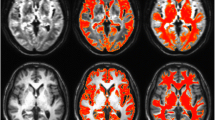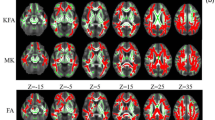Abstract
Increasing evidence demonstrates that there is marked damage and dysfunction in the white matter in Alzheimer’s disease (AD). The present study investigates the nature of white matter damage of patients with Alzheimer’s disease with diffusion tensor magnetic resonance imaging (DTI) and analyses the relationship between the white matter damage and the cognition function. DTI, as well as T1 fluid attenuated inversion recovery (FLAIR) and T2-FLAIR, was performed on probable patients of Alzheimer’s disease, and sex and age matched healthy volunteers to measure the fractional anisotropy (FA) and mean diffusivity (MD) in the genu and splenium of the corpus callosum, anterior and posterior limbs of the internal capsule, and the white matter of frontal, temporal, parietal, and occipital lobes. FA was lower in the splenium of corpus callosum, as well as in the white matter of the frontal, temporal, and parietal lobes from patients with Alzheimer’s disease than in the corresponding region from healthy controls and was strongly positive correlated with MMSE scores, whereas FA appeared no different in the anterior and posterior limbs of internal capsule, occipital lobes white matter, and the genu of corpus callosum between the patients and healthy controls. MD was significantly higher in the splenium of corpus callosum and parietal lobes white matter from patients than in that those from healthy controls and was strongly negative correlated with MMSE scores, whereas MD in the anterior and posterior limbs of internal capsule, as well as in frontal, temporal, occipital lobes white matter and the genu of corpus callosum, was not different between the patients and healthy controls. The most prominent alteration of FA and MD was in the splenium of corpus callosum. Our results suggested that white matter of patients with Alzheimer’s disease was selectively impaired and the extent of damage had a strong correlation with the cognitive function, and that selective impairment reflected the cortico–cortical and cortico–subcortical disconnections in the pathomechanism of Alzheimer’s disease. The values of FA and MD in white matter, especially in the splenium of corpus callosum in AD patients, might be a more appropriate surrogate marker for monitoring the disease progression.


Similar content being viewed by others
References
Arnold SE, Hyman BT, Flory J, Damasio AR, Van Hoesen GW (1991) The topographical and neuroanatomical distribution of neurofibrillary tangles and neuritic plaques in the cerebral cortex of patients with Alzheimer’s disease. Cereb Cortex 1:103–116
Basser PJ, Pierpaoli C (1996) Microstructural and physiological features of tissues elucidated by quantitative-diffusion-tensor MRI. J Magn Reson B 111:209–219
Benveniste H, Einstein G, Kim KR, Hulette C, Johnson GA (1999) Detection of neuritic plaques in Alzheimer’s disease by magnetic resonance microscopy. Proc Natl Acad Sci USA 96:14079–14084
Le Bihan D, Turner R, Moonen CT, Pekar J (1991) Imaging of diffusion and microcirculation with gradient sensitization: design, strategy, and significance. J Magn Reson Imaging 1:7–28
Le Bihan D, Mangin JF, Poupon C, Clark CA, Pappata S, Molko N, Chabriat H (2001) Diffusion tensor imaging: concepts and applications. J Magn Reson Imaging 13:534–546
Le Bihan D, van Zijl P (2002) From the diffusion coefficient to the diffusion tensor. NMR Biomed 15:431–434
Bozzali M, Falini A, Franceschi M, Cercignani M, Zuffi M, Scotti G, Comi G, Filippi M (2002) White matter damage in Alzheimer’s disease assessed in vivo using diffusion tensor magnetic resonance imaging. J Neurol Neurosurg Psychiatry 72:742–746
Braak H, Braak E (1998) Evolution of neuronal changes in the course of Alzheimer’s disease. J Neural Transm Suppl 53:127–140
Brun A, Englund E (1986) A white matter disorder in dementia of the Alzheimer type: a pathoanatomical study. Ann Neurol 19:253–262
Choi SJ, Lim KO, Monteiro I, Reisberg B (2005) Diffusion tensor imaging of frontal white matter microstructure in early Alzheimer’s disease: a preliminary study. J Geriatr Psychiatry Neurol 18:12–19
Conturo TE, Lori NF, Cull TS, Akbudak E, Snyder AZ, Shimony JS, McKinstry RC, Burton H, Raichle ME (1999) Tracking neuronal fiber pathways in the living human brain. Proc Natl Acad Sci USA 96:10422–10427
Davatzikos C, Resnick SM (2002) Degenerative age changes in white matter connectivity visualized in vivo using magnetic resonance imaging. Cereb Cortex 12:767–771
Filippi M, Cercignani M, Inglese M, Horsfield MA, Comi G (2001) Diffusion tensor magnetic resonance imaging in multiple sclerosis. Neurology 56:304–311
Hachinski VC, Iliff LD, Zilhka E, Du Boulay GH, McAllister VL, Marshall J, Russell RW, Symon L (1975) Cerebral blood flow in dementia. Arch Neurol 32:632–637
Han X, Holtzman DM, McKeel DW Jr (2001) Plasmalogen deficiency in early Alzheimer’s disease subjects and in animal models: molecular characterization using electrospray ionization mass spectrometry. J Neurochem 77:1168–1180
Han X, Holtzman M, McKeel DW Jr Kelley J, Morris JC (2002) Substantial sulfatide deficiency and ceramide elevation in very early Alzheimer’s disease: potential role in disease pathogenesis. J Neurochem 82:809–818
Hanyu H, Shindo H, Kakizaki D, Abe K, Iwamoto T, Takasaki M (1997) Increased water diffusion in cerebral white matter in Alzheimer’s disease. Gerontology 43:343–351
Hanyu H, Sakurai H, Iwamoto T, Takasaki M, Shindo H, Abe K (1998) Diffusion-weighted MR imaging of the hippocampus and temporal white matter in Alzheimer’s disease. J Neurol Sci 156:195–200
Head D, Buckner RL, Shimony JS, Williams LE, Akbudak E, Conturo TE, McAvoy M, Morris JC, Snyder AZ (2004) Differential vulnerability of anterior white matter in nondemented aging with minimal acceleration in dementia of the Alzheimer type: evidence from diffusion tensor imaging. Cereb Cortex 14:410–423
Hof PR, Cox K, Morrison JH (1990) Quantitative analysis of a vulnerable subset of pyramidal neurons in Alzheimer’s disease: I. superior frontal and inferior temporal cortex. J Comp Neurol 301:44–54
de Lacoste MC, Kirkpatrick JB, Ross ED (1985) Topography of the human corpus callosum. J Neuropathol Exp Neurol 44:578–591
McKhann G, Drachman D, Folstein M, Katzman R, Price D, Stadlan EM (1984) Clinical diagnosis of Alzheimer’s disease: report of the NINCDS-ADRDA Work Group under the auspices of Department of Health and Human Services Task Force on Alzheimer’s Disease. Neurology 34:939–944
O’Sullivan M, Morris RG, Huckstep B, Jones DK, Williams SC, Markus HS (2004) Diffusion tensor MRI correlates with executive dysfunction in patients with ischaemic leukoaraiosis. J Neurol Neurosurg Psychiatry 75:441–447
Pearson RC, Esiri MM, Hiorns RW, Wilcock GK, Powell TP (1985) Anatomical correlates of the distribution of the pathological changes in the neocortex in Alzheimer disease. Proc Natl Acad Sci USA 82:4531–4534
Pfefferbaum A, Sullivan EV, Hedehus M, Lim KO, Adalsteinsson E, Moseley M (2000) Age-related decline in brain white matter anisotropy measured with spatially corrected echo-planar diffusion tensor imaging. Magn Reson Med 44:259–268
Pierpaoli C, Jezzard P, Basser PJ, Barnett A, Di Chiro G (1996) Diffusion tensor MR imaging of the human brain. Radiology 201:637–648
Rogers J, Morrison JH (1985) Quantitative morphology and regional and laminar distributions of senile plaques in Alzheimer’s disease. J Neurosci 5:2801–2808
Rose SE, Chen F, Chalk JB, Zelaya FO, Strugnell WE, Benson M, Semple J, Doddrell DM (2000) Loss of connectivity in Alzheimer’s disease: an evaluation of white matter tract integrity with colour coded MR diffusion tensor imaging. J Neurol Neurosurg Psychiatry 69:528–530
Salat DH, Tuch DS, Greve DN, van der Kouwe AJ, Hevelone ND, Zaleta AK, Rosen BR, Fischl B, Corkin S, Rosas HD, Dale AM (2005) Age-related alterations in white matter microstructure measured by diffusion tensor imaging. Neurobiol Aging 26:1215–1227
Song SK, Kim JH, Lin SJ, Brendza RP, Holtzman DM (2004) Diffusion tensor imaging detects age-dependent white matter changes in a transgenic mouse model with amyloid deposition. Neurobiol Dis 15:640–647
Sugihara S, Kinoshita T, Matsusue E, Fujii S, Ogawa T (2004) Usefulness of diffusion tensor imaging of white matter in Alzheimer disease and vascular dementia. Acta Radiol 45:658–663
Sullivan EV, Adalsteinsson E, Hedehus M, Ju C, Moseley M, Lim KO, Pfefferbaum A (2001) Equivalent disruption of regional white matter microstructure in ageing healthy men and women. Neuroreport 12:99–104
Takahashi S, Yonezawa H, Takahashi J, Kudo M, Inoue T, Tohgi H (2002) Selective reduction of diffusion anisotropy in white matter of Alzheimer disease brains measured by 3.0 Tesla magnetic resonance imaging. Neurosci Lett 332:45–48
Acknowledgment
This study was supported by the National Natural Science Foundation of China (no. 3040052), the Natural Science of Foundation of Guangdong Province, China (no.20013137), and the Social Development Projects of Guangdong Province (no. 2005B10401047). We thank Ms. Mo Si-jie and Dr. Hu Tao for recruiting the subjects from Nanhai welfare centre, Guangdong Province, China. We also gratefully acknowledged Dr. Shan Hong of Department of Radiology, Third Affiliated Hospital, Sun Yat-sen University and Dr. Zhang Zhong-Wei and Dr. Wang Jian-Bo of Department of Radiology, First Affiliated Hospital, Sun Yat-sen University for their excellent technical assistance in this project. The present experiment complies with the relative law of the People’s Republic of China.
Author information
Authors and Affiliations
Corresponding author
Rights and permissions
About this article
Cite this article
Duan, JH., Wang, HQ., Xu, J. et al. White matter damage of patients with Alzheimer’s disease correlated with the decreased cognitive function . Surg Radiol Anat 28, 150–156 (2006). https://doi.org/10.1007/s00276-006-0111-2
Received:
Accepted:
Published:
Issue Date:
DOI: https://doi.org/10.1007/s00276-006-0111-2




